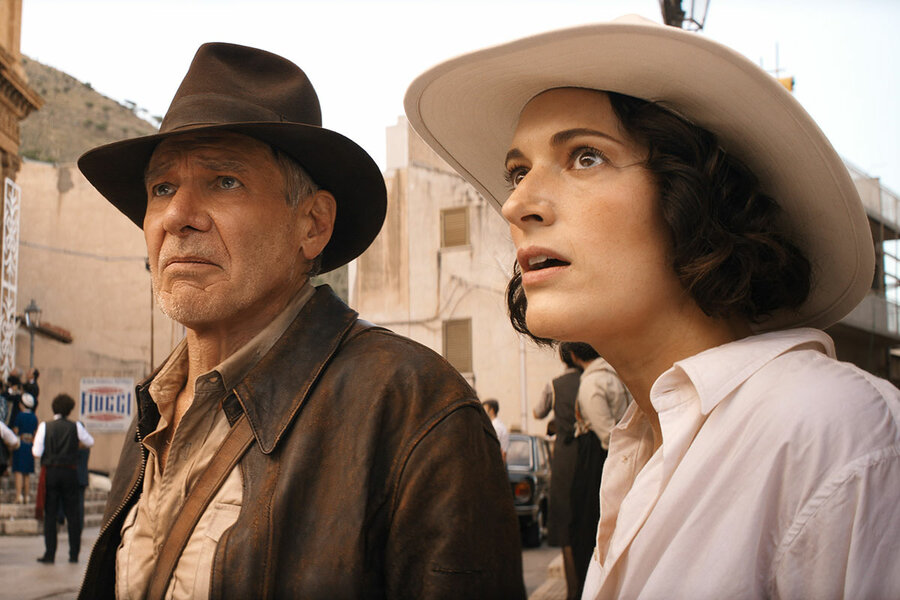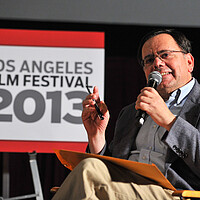Raiders of the last ark: Ford dons the fedora one more time
Loading...
“Indiana Jones and the Dial of Destiny” is the fifth and final installment of the much-loved franchise. For many, particularly of a certain age, it represents not so much a stand-alone film as a portal into the old-fashioned pleasures of moviegoing that we presumably experienced before CGI and the pandemic and everything else intervened.
It’s a serviceable thrill ride. Harrison Ford and his fedora manfully hold down the title role. But I’ve never been a cult follower of this franchise. Its escapades often seemed more processed than inspired. Since much of this new movie deliberately references the earlier installments, my wonderment remains dimmed.
Still, retro-ness has its appeal, and “Dial of Destiny” is nothing if not thumpingly old-school. It begins with Indy tangling with Nazis in the waning days of World War II. His escape, abetted by fellow captured archaeologist Basil Shaw (Toby Jones), involves lots of shootings and stabbings and stunt-double pyrotechnics aboard a speeding train. The centerpiece relic this go-round is an astronomical calculator invented by Archimedes that can reputedly create fissures in time. Indy doesn’t want it falling into the wrong hands – namely, chief Nazi bad guy Dr. Voller (Mads Mikkelsen). He, as we will find out, would like to rewrite history so the Nazis win the war.
Why We Wrote This
The latest – and last – Indiana Jones film, “Dial of Destiny,” raises the question: Can we experience action-adventure movie heroism the way we used to?
This is the first film in the series not directed by Steven Spielberg or co-written by George Lucas. James Mangold, who also co-wrote, inherited the gig – but I didn’t detect much of a difference. As a piece of action filmmaking, it’s actually an improvement over the previous entry in the franchise, the laggard 2008 “Crystal Skull.”
The big change, of course, is Ford, who was pushing 80 when the film was shot. The WWII sequences, where Indy is still relatively spry, put Ford through the digital de-aging process that creeped so many of us out when it was used on Al Pacino and Robert De Niro in “The Irishman.” The results here are much improved, though Ford’s gravelly voice, which has not been altered, undercuts the effect.
Soon enough, the film flashes forward to the summer of 1969, around the time of the moon landing. Indy is separated from his wife, Marion (Karen Allen, who makes a very brief appearance). Their son, we have learned, has been killed in Vietnam. Indy’s living alone in a crummy Manhattan apartment, drinking too much, wrapping up his last boring college archaeology class, and wearily welcoming his newfound retirement.
Then he’s reluctantly roped back into the fray by his goddaughter Helena (Phoebe Waller-Bridge from “Fleabag”), Basil’s daughter, who needs him to help locate the dial, although her interests appear to be more mercenary than archaeological. What follows is an overlong concatenation of OK set pieces featuring oodles of predictable globe-hopping derring-do.
Perhaps older audiences, much like Ford himself, will feel the nostalgic need to de-age and revisit this bygone world. Although “Dial of Destiny” is far from CGI-free, it may still resonate with moviegoers – though perhaps not with newbie viewers – who feel assaulted by the cosmic clatter of the Marvel and DC flicks. Having Nazis as the bad guys may also have its retro appeal, but with neo-Nazism on the global rise, that bit of pulp villainy sits especially uneasily on the screen these days. So, for that matter, do the Vietnam references. Fantasy films do not benefit from specifying real-world horrors.
A larger point raised by this film is, can we experience action-adventure movie heroism the way we used to? “Dial of Destiny” may not be a true test case. The franchise is iconic, the film is deliberately anachronistic, and at this point it probably won’t spawn retreads. But for many people, it could summon memories of the good-time moviegoing experience as it once was, even if that memory is rose-tinted. Nostalgia isn’t about how things really were. It’s about how we wanted them to be. For these moviegoers, “Dial of Destiny” will likely offer up its own fissure in time.
Peter Rainer is the Monitor’s film critic. “Indiana Jones and the Dial of Destiny” is rated PG-13 for sequences of violence and action, language, and smoking.









